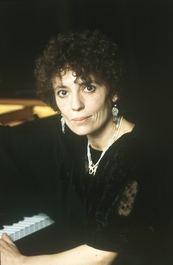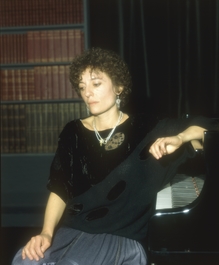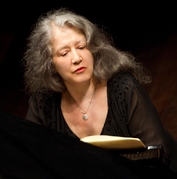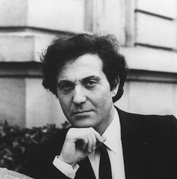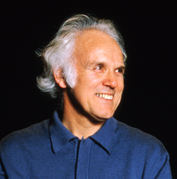

Maria-João Pires
News
Happy 70th birthday to Maria João Pires!
Memories of this have faded now, but when Maria João Pires hit the international stage in the early 1970s, in the wake of winning first prize at the Beethoven Bicentennial Competition in Brussels, she caught many music-lovers off-guard.
Cyclone Argerich had just blown through, with all that blistering piano technique and dramatic re-readings of vast swathes of the repertoire, from Chopin to Prokofiev. It came as a huge surprise, therefore, to be taken back to an art that seemed to come from another age – simple, luminous and above all profoundly musical playing that seemed to scorn virtuosic display.
At this point, Pires’ programmes featured Bach, Beethoven, Schubert and, especially, Mozart. Chopin was to follow. This scrap of a woman, who seemed so determined, so single-minded, brought to mind pianists of days gone by, particularly, in terms of the sheer clarity of her playing, such figures as Clara Haskil and Lili Kraus – two other great exponents of Mozart, of course.
There was no Iberian or French music yet, her gaze set firmly and exclusively on the Austro-German repertoire and, as far as concertos were concerned, on Bach and Mozart.
Pires’ first teacher, Campos Coelho, had fought constant battles with her, but was to discover he had met his match. He advised her mother to beat her in order to tame her character, but in vain – Maria João spent ten years defying him. Her little hands saved her. She could not be turned into a virtuoso and she was already a musician. What could Coelho contribute apart from discipline? At fifteen, she broke away from him. Her meeting with Francine Benoît, pupil of D’Indy, taught her that everything lay in the score, and that a performer had to disappear into the work, although it must be said this merely confirmed what she already believed.
She later moved to Germany to continue her studies: not, initially, an altogether positive experience. Then, however, Wilhelm Kempff heard her play. Did he perhaps recognise himself in the luminous sonorities, ‘hammerless’ touch and simplicity of melodic line that had already become her trademark qualities?
He took her under his wing and gave her access to a spiritual dimension that liberated her playing. She is probably the only living heir of Kempff, a German with his roots in a bygone culture, a musician fascinated by the South.
Next for Pires it was farewell to Munich, and hello to Hanover. There, she finally found not a teacher but a musician with whom she could exchange ideas and perfect her playing: Karl Engel.
Her sound is tinged with bronze, her phrases breathe freely, beneath her fingers the keyboard glows, irradiated by a magical ‘hammerless’ touch as opposed to the tempered steel virtuosos then performing around the world. Something of the art of greats such as Perlemuter, Horszowski, and Novaes lives on in the light-drenched keyboard of Pires.
Her recording career began relatively late. Michel Garcin, founder and deus ex machine of Erato, had links with the Gulbenkian Foundation. One of the French label’s major artists, Michel Corboz, was chorus director there, and the warm acoustic of the Teatro Sao Carlos made an ideal location for recording sessions. Garcin had been following Pires since her Brussels win, and his catalogue was lacking in piano music. A Baroque enthusiast himself, who favoured the Classical era over Romanticism or Modernism, Garcin had now found in Pires a pianist who perfectly fitted Erato’s artistic image, one who far from being a stage diva was discretion personified. Mozart was an obvious choice from the start. The selection of concertos brought to the attention of the audience a pianist they would take to their hearts.
The Mozart recordings then moved to Lausanne, where Pires enjoyed a felicitous collaboration with Armin Jordan. A few select Bach and Beethoven sonatas, Schubert for two and four hands, Schumann and Chopin – supremely elegant renderings of the classic waltzes reminding us of Pires’ long-held admiration for Dinu Lipatti, and two concertos imbued with an unmistakably Lusitanian melancholy – the early recordings brought together here tell us just how intimately her art was already interwoven with their music. –Jean-Charles Hoffelé (translated by Susannah Howe)
Extract from the liner notes of the 17-CD boxed set Maria João Pires: The Complete Erato Recordings, 1972-87.
Erato celebrates Maria João Pires’ 70th birthday with 17-CD boxed set
No one does the classics like Maria. She is one of these rare pianists who quietly gets out of the way in order to let the soul of the music shine through, presenting the composers’ intentions in their purest form, always poised without losing her joyous spontaneity.
Renowned precisely for not having a diva temperament, Pires told Gramophone: “It’s the music itself [not the performer] that people should go to listen to — a concert should allow one to experience some kind of emotion… to dream… Life is so short — we should try to live things more intensely.”
By remaining staunchly devoted to the Austro-German repertoire from Bach to Schumann — with a lyrical dose of Chopin for good measure — Pires has stayed true to her eloquent classical and Romantic sensibility. No surprise, given that she was the young protégée of Wilhelm Kempff in Germany.
This 17-CD collection of Pires’ complete Erato Recordings begins with the Bach Keyboard Concertos conducted by Michel Corboz, moving on to Mozart sonatas and concertos and Schubert piano duets (with Hüseyin Sermet). Previously unreleased recordings to discover within the set: Beethoven’s Sonatas Op 109 and 110; Mozart Concertos Nos 8 & 27 conducted by Claudio Scimone.
Maria João Pires celebrates her 70th birthday in a recital at London’s Wigmore Hall later this year.
Related releases




